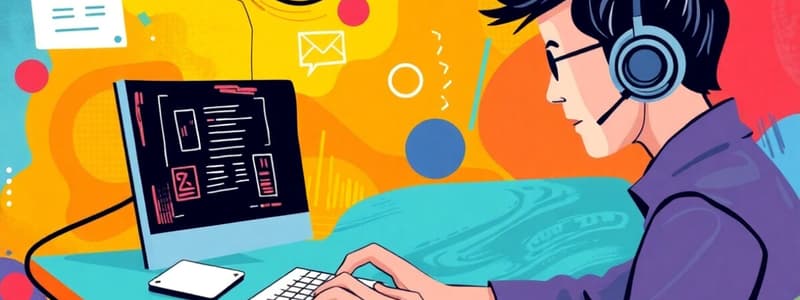Podcast
Questions and Answers
E-learning strictly refers to physical classroom teaching broadcast to remote locations.
E-learning strictly refers to physical classroom teaching broadcast to remote locations.
False (B)
Reducing educational costs is a primary aim of e-learning.
Reducing educational costs is a primary aim of e-learning.
True (A)
Synchronous e-learning involves communication that does not require simultaneous presence of teacher and student.
Synchronous e-learning involves communication that does not require simultaneous presence of teacher and student.
False (B)
Voice communication over the Internet is a form of synchronous e-learning.
Voice communication over the Internet is a form of synchronous e-learning.
Educational television exclusively uses pre-recorded content and cannot broadcast live events.
Educational television exclusively uses pre-recorded content and cannot broadcast live events.
Video conferencing does not allow parties in geographically distant locations to communicate in real-time.
Video conferencing does not allow parties in geographically distant locations to communicate in real-time.
Printed materials are irrelevant in modern e-learning environments.
Printed materials are irrelevant in modern e-learning environments.
Databases used in e-learning exclusively contain full-text books and articles.
Databases used in e-learning exclusively contain full-text books and articles.
E-learning cannot utilize virtual classrooms to replicate traditional learning environments.
E-learning cannot utilize virtual classrooms to replicate traditional learning environments.
A primary benefit of Google Drive for e-learning is the ability to synchronize files across different user devices.
A primary benefit of Google Drive for e-learning is the ability to synchronize files across different user devices.
Instructional platforms are characterized by focusing exclusively on written assignments, excluding playing techniques in education.
Instructional platforms are characterized by focusing exclusively on written assignments, excluding playing techniques in education.
Google Drive is exclusive with a fee, and does not offer free file storage services.
Google Drive is exclusive with a fee, and does not offer free file storage services.
E-learning management systems focus solely on delivering content and lack features for managing admissions or assignments.
E-learning management systems focus solely on delivering content and lack features for managing admissions or assignments.
All Commercial e-learning management systems freely provide users with source code.
All Commercial e-learning management systems freely provide users with source code.
Tadarus, Majd and Jsoor systems, globally used across higher-education and academic institutions, were developed incorporating exclusively Latin script.
Tadarus, Majd and Jsoor systems, globally used across higher-education and academic institutions, were developed incorporating exclusively Latin script.
Flashcards
What is E-learning?
What is E-learning?
The use of modern electronic media and information technologies to facilitate education.
What are the aims of E-learning?
What are the aims of E-learning?
To reduce costs, administrative burdens, and fill faculty shortages.
What is Synchronous E-learning?
What is Synchronous E-learning?
Enables real-time communication between teacher and learner.
What is Asynchronous E-learning?
What is Asynchronous E-learning?
Signup and view all the flashcards
What is Educational Television?
What is Educational Television?
Signup and view all the flashcards
What are Video Conferences?
What are Video Conferences?
Signup and view all the flashcards
What are Printed Materials in E-learning?
What are Printed Materials in E-learning?
Signup and view all the flashcards
What are Databases in E-learning?
What are Databases in E-learning?
Signup and view all the flashcards
How is the Internet used in E-learning?
How is the Internet used in E-learning?
Signup and view all the flashcards
What are Virtual Classrooms?
What are Virtual Classrooms?
Signup and view all the flashcards
What are Social Networks in E-learning?
What are Social Networks in E-learning?
Signup and view all the flashcards
What are Learning Management Systems (LMS)?
What are Learning Management Systems (LMS)?
Signup and view all the flashcards
What is the Moodle System?
What is the Moodle System?
Signup and view all the flashcards
What are Commercial E-learning Systems?
What are Commercial E-learning Systems?
Signup and view all the flashcards
What is Google Drive?
What is Google Drive?
Signup and view all the flashcards
Study Notes
- Course Name: Computer Skills
- Code: CMP 100
- Program: Events Management and Organizing
- Academic year: 1446 (Hijri)
E-Learning Definition
- E-learning is the use of modern electronic media, information, and communication technologies.
- E-learning facilitates education with minimal time and effort, maximizing benefits.
- Electronic media includes computers, networked devices, digital media (images, text, audio), search mechanisms, e-libraries, internet gateways, and portals.
- E-learning delivers education/training through educational technologies.
- E-learning enables broadcasting from an educational institution to geographically distant recipients.
- E-learning offers educational options for students unable to attend traditional programs.
Aims of E-Learning
- Reduces educational costs and overcomes limitations of educational institutions
- Expands admission opportunities and increases learner numbers
- Decreases administrative burdens in academic courses.
- Addresses shortages of qualified faculty, teachers, and trainers.
- Provides flexibility and freedom from traditional education constraints.
- Allows study that fits individual learner conditions, eliminating travel to university centers/training institutes.
- Promotes justice in learning opportunities for all aspiring individuals.
- Encourages independence in learning and research and distributes a self-learning culture.
- Reduces differences between learners by offering diverse educational resources.
- Enhances the quality of education using attractive charts and animated clips, which summarize information.
- Develops the skills of learners and teachers, particularly technical skills.
Types of E-Learning
- Synchronous education allows direct interaction between teachers and learners via the internet in real-time.
- Synchronous methodologies include written communication (instant text messaging), voice communication (over the internet), and audio/video communication (video conferencing).
- Asynchronous education does not require simultaneous presence
- Relies on methods such as email or voicemail
- Teachers can post resources on websites for students to access without real-time communication.
- A disadvantage is the delayed feedback and potential loss of interaction with teachers and peers.
E-Learning Technologies
- Educational television uses a common and familiar tool.
- Television supports audio and video for presenting complex concepts effectively.
- Television demonstrates practical applications and hands-on concepts
- Augments the efficiency of presented educational content through field trips
- Television virtually transports students to unfamiliar locations (the moon, planets, or foreign countries).
- Live broadcasts and capturing events for educational purposes.
- Television summarizes and reviews concepts.
- Video conferences are modern, efficient educational technologies that allow real-time teacher-student communication.
- Supports the use of whiteboards, documents and videos.
- Connects geographically separate individuals in real-time.
- Gives immediate feedback through direct interaction with instructors and classmates.
- Video conferencing necessitates costly equipment and substantial teacher effort to keep students connected.
- Printed resources provides materials as hard or soft copies forming a basic component of e-learning.
- Printed resources are user-friendly
- Examples include textbooks, curricula, objectives and references.
Internet
- Supports e-learning via email for message and information exchange.
- Facilitates student feedback.
- Utilizes whiteboards for student interaction and virtual classes for reinforcement
- Internet provides material regarding class, courses, exercises, references, etc
- Internet provides information about the instructor.
Databases
- Organizes collections of searchable records.
- Covers specific subjects or timeframes.
- includes library databases with book and periodical abstracts.
Virtual Classes
- Advances in technology reinforce teachers and learners effectiveness.
- Terminology for digital educational advancement:
- Paperless world
- Universities without walls
- Next-generation learning environment
- Electronic schools and universities
- Virtual educational environments
- Virtual universities
- Digital curriculum
- Smart and virtual classrooms
- Virtual classrooms offer online learning environments mimicking traditional classrooms and negate time/space limitations
- Used for collaborative learning online.
E-Learning Tools
- Social networks like WhatsApp, Telegram, Facebook, and Twitter enable users to create and share content via smart devices
- The most commonly used tools are social networks.
- Social networks allow educational success and empowerment
- Participation is encouraged through synchronous and asynchronous methodologies.
Learning Management Systems
- Integrated software manages and evaluates educational activities and tools.
- E-learning requires electronic management for communication and integration.
- LMS support are for tasks related to managing admission, registration, virtual classrooms, assignments, tests, and student progress.
Open Source E-Learning Management Systems
- Moodle system is useful for teachers to provide electronic learning.
- Moodle offers flexible web pages
- Supports over 45 languages including Arabic
- Is used worldwide by educational facilities.
- Dokeos system activates cooperation between groups and supports the creation of educational content, having a global presence.
- Dokeos supports 34 languages
- ATutor allows teachers to update the interface
- ATutor system supports 30 languages
Commercial E-Learning Management Systems
- For-profit systems require a license for use
- WebCT manages e-learning with tools for preparing courses in educational institutions.
- Blackboard system mirrors the traditional classroom and provides learning opportunities to help quality education.
- The most used system is Blackboard and it supports flexibility and can be widely expanded
- Tadarus, from Harf Information Technology is built in Arabic and used in some Saudi universities
- Majd is built in Arabic to manage virtual classrooms, monitor work, and supervise learners.
- Jsoor manages educational content.
Instructional Platforms
- Numerous applications are designed for e-learning on smart devices.
- These platforms use discovery and playing techniques.
- Specific platforms mentioned include MIT, Edx, Edraak, and Rwaq.
Quality Standards in E-Learning
- Success in education relies on adhering to international quality standards.
- Use direct and indirect communication.
- Encourage cooperation in learning.
- Provide evaluations.
- Adapting content and assessment to meet diverse needs.
- Produce good digital content (design and content).
- Apply discovery and play techniques.
- Supply learners with search-friendly sites.
- Share videos on platforms through cloud services like Google Drive.
Google Drive
- Google Drive is available with upgradeable storage options for monthly fees.
- Functions as a "Cloud Storage Service" with secure cloud storage
- Sync various user devices and secure files from damage/loss.
- Stores files safely.
- Access Google Drive from computers or mobile devices with an internet connection.
- A Gmail account is necessary for access.
- Enables sharing and collaboration.
Studying That Suits You
Use AI to generate personalized quizzes and flashcards to suit your learning preferences.




